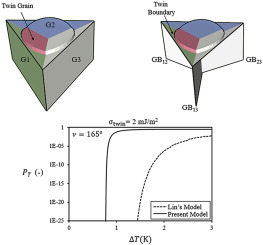当前位置:
X-MOL 学术
›
Acta Mater.
›
论文详情
Our official English website, www.x-mol.net, welcomes your feedback! (Note: you will need to create a separate account there.)
Twinning mechanism at three-grain tri-junction during directional solidification of multi-crystalline silicon
Acta Materialia ( IF 9.4 ) Pub Date : 2018-02-01 , DOI: 10.1016/j.actamat.2017.10.042 T. Jain , H.K. Lin , C.W. Lan
Acta Materialia ( IF 9.4 ) Pub Date : 2018-02-01 , DOI: 10.1016/j.actamat.2017.10.042 T. Jain , H.K. Lin , C.W. Lan

|
Abstract We propose a model to explain the formation mechanism of twin grains at the three-grain tri-junction (3GTJ) on the growth interface during directional solidification of multi-crystalline silicon. We also attempt to confirm its validity by comparing with the experimental results. This model is an extension of the previous model for the two-dimensional (2D) nucleation at the grain boundaries (GBs). It is found that the energy barriers for faceting and twinning nucleus at the 3GTJ are much smaller than that at GBs. As a result, a higher twinning probability can be obtained at a much lower undercooling. Two types of tri-junctions are considered according to the experiments and the dominant factors which decide the twinning probability on each facet at the 3GTJ are further discussed.
中文翻译:

多晶硅定向凝固过程中三晶三结的孪晶机制
摘要 我们提出了一个模型来解释多晶硅定向凝固过程中生长界面上三晶三结(3GTJ)处孪晶的形成机制。我们还尝试通过与实验结果进行比较来确认其有效性。该模型是先前用于在晶界 (GB) 处进行二维 (2D) 成核的模型的扩展。结果表明,3GTJ 的刻面和孪晶核的能垒比 GB 小得多。因此,可以在低得多的过冷度下获得更高的孪生概率。根据实验考虑了两种类型的三结点,并进一步讨论了决定 3GTJ 每个面的孪生概率的主导因素。
更新日期:2018-02-01
中文翻译:

多晶硅定向凝固过程中三晶三结的孪晶机制
摘要 我们提出了一个模型来解释多晶硅定向凝固过程中生长界面上三晶三结(3GTJ)处孪晶的形成机制。我们还尝试通过与实验结果进行比较来确认其有效性。该模型是先前用于在晶界 (GB) 处进行二维 (2D) 成核的模型的扩展。结果表明,3GTJ 的刻面和孪晶核的能垒比 GB 小得多。因此,可以在低得多的过冷度下获得更高的孪生概率。根据实验考虑了两种类型的三结点,并进一步讨论了决定 3GTJ 每个面的孪生概率的主导因素。



























 京公网安备 11010802027423号
京公网安备 11010802027423号